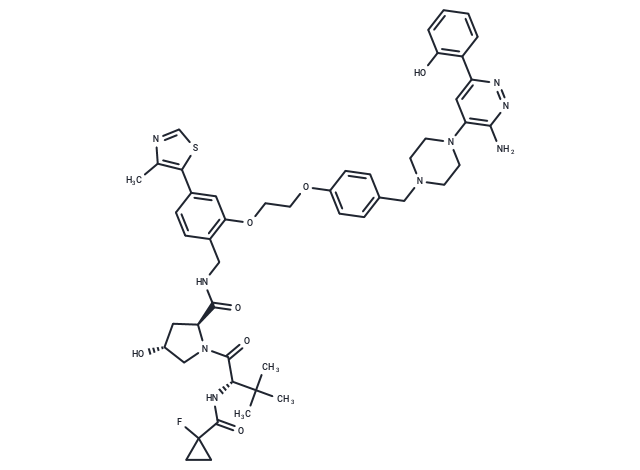Shopping Cart
- Remove All
 Your shopping cart is currently empty
Your shopping cart is currently empty

ACBI1 is a potent PROTAC degrader of BAF ATPase subunits SMARCA2 and SMARCA4, also degrades the polybromo-associated BAF (PBAF) complex member PBRM1, with DC50s of 6 nM, 11 nM and 32 nM for SMARCA2, SMARCA4 and PBRM1 in MV-4-11 cells, respectively. ACBI1 is composed of a bromodomain ligand, a linker, and the E3 ubiquitin ligase VHL. ACBI1 can induce anti-proliferative effects and apoptosis.

| Pack Size | Price | Availability | Quantity |
|---|---|---|---|
| 1 mg | $98 | In Stock | |
| 5 mg | $237 | In Stock | |
| 10 mg | $382 | In Stock | |
| 25 mg | $639 | In Stock | |
| 50 mg | $913 | In Stock | |
| 100 mg | $1,230 | In Stock |
| Description | ACBI1 is a potent PROTAC degrader of BAF ATPase subunits SMARCA2 and SMARCA4, also degrades the polybromo-associated BAF (PBAF) complex member PBRM1, with DC50s of 6 nM, 11 nM and 32 nM for SMARCA2, SMARCA4 and PBRM1 in MV-4-11 cells, respectively. ACBI1 is composed of a bromodomain ligand, a linker, and the E3 ubiquitin ligase VHL. ACBI1 can induce anti-proliferative effects and apoptosis. |
| Targets&IC50 | SMARCA2:6 nM (DC50), SMARCA4:11 nM (DC50), PBRM1:32 nM (DC50) |
| Molecular Weight | 936.1 |
| Formula | C49H58FN9O7S |
| Cas No. | 2375564-55-7 |
| Smiles | NC1=C(C=C(N=N1)C2=C(O)C=CC=C2)N3CCN(CC4=CC=C(OCCOC5=C(CNC(=O)[C@H]6N(C([C@@H](NC(=O)C7(F)CC7)C(C)(C)C)=O)C[C@H](O)C6)C=CC(=C5)C8=C(C)N=CS8)C=C4)CC3 |
| Relative Density. | 1.41 g/cm3 (Predicted) |
| Storage | Powder: -20°C for 3 years | In solvent: -80°C for 1 year | Shipping with blue ice. | |||||||||||||||||||||||||||||||||||
| Solubility Information | DMSO: 100 mg/mL (106.83 mM), Sonication is recommended. | |||||||||||||||||||||||||||||||||||
Solution Preparation Table | ||||||||||||||||||||||||||||||||||||
DMSO
| ||||||||||||||||||||||||||||||||||||

Copyright © 2015-2025 TargetMol Chemicals Inc. All Rights Reserved.